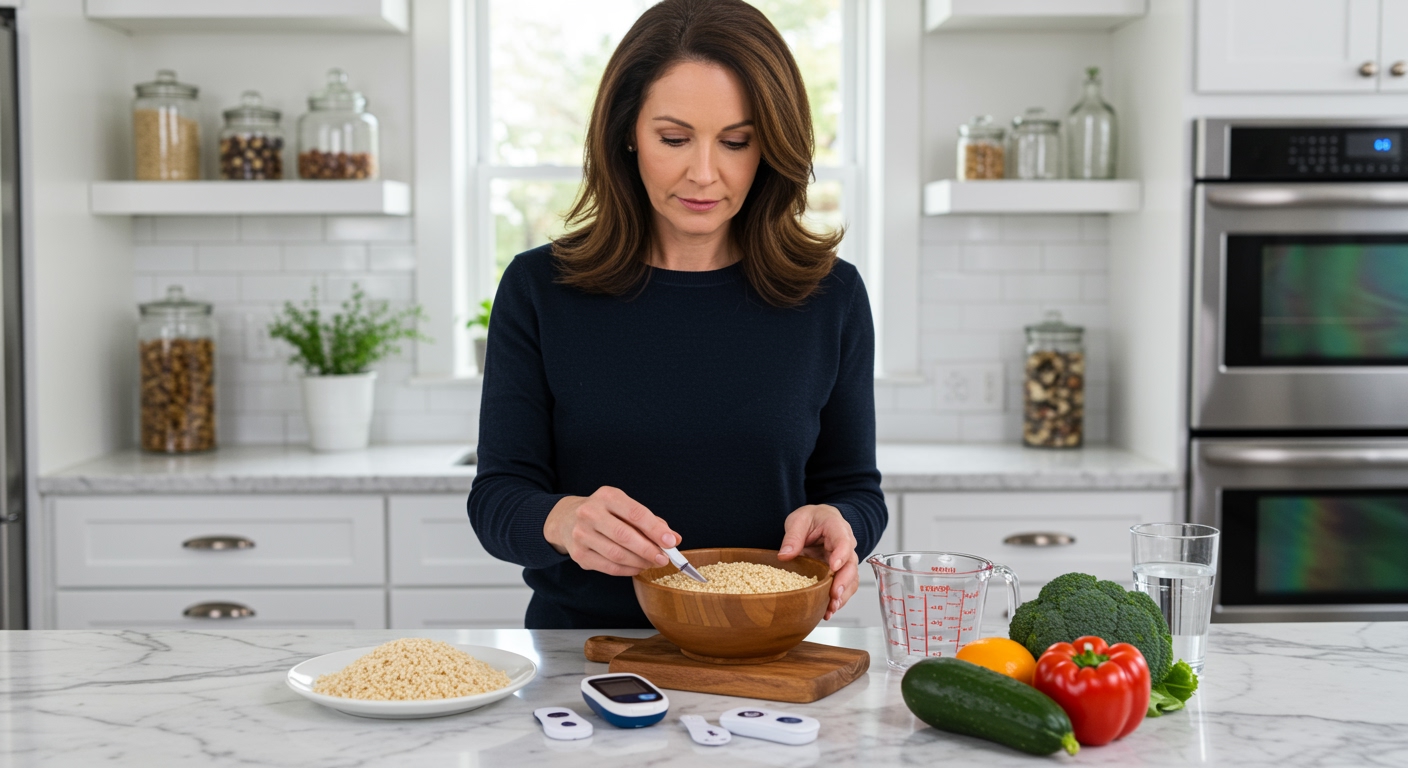✪ Key Takeaway: Brown rice can be part of a diabetes diet when eaten in controlled portions, but it still raises blood sugar significantly.
Introduction
Your doctor says avoid white rice, but what about brown rice?
You might be asking this question because you love rice but worry about your blood sugar levels.
Hi, I am Abdur, your nutrition coach and today I am going to explain whether brown rice is truly safe for diabetes and how it affects your blood glucose.
How Does Brown Rice Affect Blood Sugar Levels?
Brown rice has a glycemic index of 50-55, which puts it in the medium range for blood sugar impact.
This means brown rice will still raise your blood glucose, but more slowly than white rice.
The fiber content in brown rice helps slow down sugar absorption in your intestines.
However, one cup of cooked brown rice contains about 45 grams of carbohydrates, which your body converts to glucose.
Your pancreas must produce insulin to handle this glucose load, and if you have diabetes, this process does not work efficiently.
Studies show that people with diabetes experience blood sugar spikes of 30-50 mg/dL after eating brown rice, though this is lower than white rice.
✪ Fact: Brown rice takes 2-3 hours to fully digest compared to 1-2 hours for white rice.
What Makes Brown Rice Different From White Rice?
Brown rice keeps its bran layer and germ intact, while white rice has these parts removed during processing.
The bran layer contains fiber, B vitamins, and minerals that help your body process carbohydrates more effectively.
This fiber content slows down the breakdown of starch into glucose, creating a more gradual rise in blood sugar.
White rice causes faster and higher blood sugar spikes because it lacks this protective fiber barrier.
The magnesium in brown rice also helps your cells use insulin more efficiently, which benefits people with diabetes.
However, both types of rice are still high in carbohydrates and will impact your blood glucose levels significantly.
✪ Pro Tip: Always measure your rice portions using a measuring cup rather than estimating by eye.
How Much Brown Rice Can You Safely Eat?
The safe amount depends on your individual blood sugar response and overall carbohydrate tolerance.
Most diabetes experts recommend starting with a quarter cup of cooked brown rice per meal.
This portion contains about 11 grams of carbohydrates, which is manageable for most people with diabetes.
You can gradually increase to half a cup if your blood sugar readings remain stable after meals.
Never eat brown rice alone – always pair it with protein and healthy fats to slow down glucose absorption.
Good combinations include brown rice with grilled chicken and vegetables, or brown rice with beans and olive oil.
Monitor your blood sugar 2 hours after eating to understand how your body responds to different portion sizes.
✪ Note: Your medication timing may need adjustment when adding brown rice to your meals.
What Are Better Alternatives To Brown Rice?
Several grain alternatives have lower carbohydrate content and less impact on blood glucose.
Cauliflower rice contains only 5 grams of carbs per cup compared to 45 grams in brown rice.
Shirataki rice made from konjac root has virtually zero carbohydrates and will not raise your blood sugar.
Quinoa provides more protein than brown rice and has a slightly lower glycemic impact.
Wild rice contains more fiber and protein than brown rice, making it a better choice for blood sugar control.
You can also try mixing small amounts of brown rice with these lower-carb alternatives to reduce the overall impact.
✪ Pro Tip: Prepare cauliflower rice in batches and freeze portions for quick diabetes-friendly meals.
When Should You Avoid Brown Rice Completely?
Some people with diabetes should avoid brown rice entirely based on their individual health status.
If your HbA1c levels are above 8 percent, focus on very low carbohydrate foods until you achieve better control.
People with gastroparesis should avoid brown rice because the fiber can worsen delayed stomach emptying.
If you experience blood sugar spikes above 180 mg/dL after eating small portions, brown rice is not suitable for you.
Those following very low carb or ketogenic diets for diabetes management should eliminate brown rice completely.
Always consult your healthcare provider before adding brown rice back into your diet if you have severe diabetes complications.
✪ Note: Your diabetes medication effectiveness can change when you modify your carbohydrate intake significantly.
The Bottom Line
Brown rice can be part of a diabetes diet when eaten in controlled portions and combined with protein and healthy fats.
The key to managing diabetes is not avoiding all carbohydrates but learning to control portions and timing.
Share your experience with brown rice and diabetes in the comments below – I would love to hear how your body responds to different portion sizes.
References
At NutritionCrown, we use quality and credible sources to ensure our content is accurate and trustworthy. Below are the sources referenced in creating this article:
- Harvard Health: Brown rice versus white rice: A head-to-head comparison
- PubMed: Effects of brown rice on blood glucose levels
- PMC: Rice consumption and diabetes management
- Healthline: Brown Rice for Diabetes





